A Bibliometric Analysis of the Studies on Self-Healing Concrete Published between 1974 and 2021
Abstract
:1. Introduction
2. Methods
2.1. Data Collection
2.2. Software Selection
2.3. Analysis
3. Results and Discussion
3.1. Overview of the Retrieved Data
3.2. Research Constituents Analysis
3.2.1. Authors
3.2.2. Countries and Institution Analysis
3.2.3. Publication Analysis
3.3. Keyword Analysis
4. Limitations
5. Conclusions
Author Contributions
Funding
Institutional Review Board Statement
Informed Consent Statement
Data Availability Statement
Conflicts of Interest
References
- Zhang, W.; Zheng, Q.; Ashour, A.; Han, B. Self-Healing Cement Concrete Composites for Resilient Infrastructures: A Review. Compos. Part B Eng. 2020, 189, 107892. [Google Scholar] [CrossRef]
- Sidiq, A.; Gravina, R.; Giustozzi, F. Is Concrete Healing Really Efficient? A Review. Constr. Build. Mater. 2019, 205, 257–273. [Google Scholar] [CrossRef]
- Du, X.; Fang, H.; Wang, S.; Xue, B.; Wang, F. Experimental and Practical Investigation of the Sealing Efficiency of Cement Grouting in Tortuous Fractures with Flowing Water. Tunn. Undergr. Space Technol. 2021, 108, 103693. [Google Scholar] [CrossRef]
- Yoo, D.-Y.; Oh, T.; Shin, W.; Kim, S.; Banthia, N. Tensile Behavior of Crack-Repaired Ultra-High-Performance Fiber-Reinforced Concrete under Corrosive Environment. J. Mater. Res. Technol. 2021, 15, 6813–6827. [Google Scholar] [CrossRef]
- Satapathy, A.; Dhale, Y.; Patnaik, S.; Meena, T. Case Study on Cracks and Its Paraphernalia. Mater. Today Proc. 2021, 45, 3560–3563. [Google Scholar] [CrossRef]
- Wang, X.F.; Yang, Z.H.; Fang, C.; Han, N.X.; Zhu, G.M.; Tang, J.N.; Xing, F. Evaluation of the Mechanical Performance Recovery of Self-Healing Cementitious Materials—Its Methods and Future Development: A Review. Constr. Build. Mater. 2019, 212, 400–421. [Google Scholar] [CrossRef]
- Vijay, K.; Murmu, M.; Deo, S.V. Bacteria Based Self Healing Concrete—A Review. Constr. Build. Mater. 2017, 152, 1008–1014. [Google Scholar] [CrossRef]
- Alhalabi, Z.S.; Dopudja, D. Self-Healing Concrete: Definition, Mechanism and Application in Different Types of Structures. Int. Res. J. 2017, 5. [Google Scholar] [CrossRef]
- Mahmoodi, S.; Sadeghian, P. Self-Healing Concrete: A Review of Recent Research Developments and Existing Research Gaps. In Proceedings of the 7th International Conference on Engineering Mechanics and Materials, Laval, QC, Canada, 12–15 June 2019; Canadian Society for Civil Engineering (CSCE): Point Claire, QC, Canada, 2019. [Google Scholar]
- Xu, J.; Yao, W. Multiscale Mechanical Quantification of Self-Healing Concrete Incorporating Non-Ureolytic Bacteria-Based Healing Agent. Cem. Concr. Res. 2014, 64, 1–10. [Google Scholar] [CrossRef]
- Sonali Sri Durga, C.; Ruben, N.; Sri Rama Chand, M.; Venkatesh, C. Performance Studies on Rate of Self Healing in Bio Concrete. Mater. Today: Proc. 2020, 27, 158–162. [Google Scholar] [CrossRef]
- Nasim, M.; Dewangan, U.K.; Deo, S.V. Autonomous Healing in Concrete by Crystalline Admixture: A Review. Mater. Today: Proc. 2020, 32, 638–644. [Google Scholar] [CrossRef]
- Yang, Q.; Jinbang, W.; Lianwang, Y.; Zonghui, Z. Effect of Graphene and Carbon Fiber on Repairing Crack of Concrete by Electrodeposition. Ceram. Silik. 2019, 63, 403–412. [Google Scholar] [CrossRef]
- Wang, J.Y.; Soens, H.; Verstraete, W.; De Belie, N. Self-Healing Concrete by Use of Microencapsulated Bacterial Spores. Cem. Concr. Res. 2014, 56, 139–152. [Google Scholar] [CrossRef]
- Feng, J.; Dong, H.; Wang, R.; Su, Y. A Novel Capsule by Poly (Ethylene Glycol) Granulation for Self-Healing Concrete. Cem. Concr. Res. 2020, 133, 106053. [Google Scholar] [CrossRef]
- Da Silva, F.B.; De Belie, N.; Boon, N.; Verstraete, W. Production of Non-Axenic Ureolytic Spores for Self-Healing Concrete Applications. Constr. Build. Mater. 2015, 93, 1034–1041. [Google Scholar] [CrossRef]
- Aria, M.; Cuccurullo, C. Bibliometrix: An R-Tool for Comprehensive Science Mapping Analysis. J. Informetr. 2017, 11, 959–975. [Google Scholar] [CrossRef]
- Song, T.; Jiang, B.; Li, Y.; Ji, Z.; Zhou, H.; Jiang, D.; Seok, I.; Murugadoss, V.; Wen, N.; Colorado, H. Self-Healing Materials: A Review of Recent Developments. Es Mater. Manuf. 2021, 14, 1–19. [Google Scholar] [CrossRef]
- Linnenluecke, M.K.; Marrone, M.; Singh, A.K. Conducting Systematic Literature Reviews and Bibliometric Analyses. Aust. J. Manag. 2020, 45, 175–194. [Google Scholar] [CrossRef]
- Donthu, N.; Kumar, S.; Mukherjee, D.; Pandey, N.; Lim, W.M. How to Conduct a Bibliometric Analysis: An Overview and Guidelines. J. Bus. Res. 2021, 133, 285–296. [Google Scholar] [CrossRef]
- Aria, M.; Cuccurullo, C. Biblioshiny—The Shiny Interface for Bibliometrix. Available online: https://www.bibliometrix.org/Biblioshiny.html (accessed on 25 August 2021).
- Elsevier About Scopus—Abstract and Citation Database | Elsevier. Available online: https://www.elsevier.com/solutions/scopus (accessed on 28 August 2021).
- Harzing, A.-W. Metrics: H and g-Index. Available online: https://harzing.com/resources/publish-or-perish/tutorial/metrics/h-and-g-index (accessed on 16 June 2022).
- Librarians, S.C. LibGuides: Measuring Research Impact: Author Metrics. Available online: https://guides.library.txstate.edu/c.php?g=184599&p=7022680 (accessed on 16 June 2022).
- Yu, F.; Hayes, B. Applying Data Analytics and Visualization to Assessing the Research Impact of the Cancer Cell Biology (CCB) Program at the University of North Carolina at Chapel Hill. J. Escience Librariansh. 2018, 7, e1123. [Google Scholar] [CrossRef]
- Xie, H.; Zhang, Y.; Choi, Y.; Li, F. A Scientometrics Review on Land Ecosystem Service Research. Sustainability 2020, 12, 2959. [Google Scholar] [CrossRef]
- Goksu, I. Bibliometric Mapping of Mobile Learning. Telemat. Inform. 2021, 56, 101491. [Google Scholar] [CrossRef]
- Statista Cement: Production Ranking Top Countries 2021. Available online: https://www.statista.com/statistics/267364/world-cement-production-by-country/ (accessed on 16 June 2022).
- Muynck, W.D.; Belie, N.D.; Verstraete, W. Microbial Carbonate Precipitation in Construction Materials: A Review. Ecol. Eng. 2010, 36, 118–136. [Google Scholar] [CrossRef]
- Jonkers, H.M.; Thijssen, A.; Muyzer, G.; Copuroglu, O.; Schlangen, E. Application of Bacteria as Self-Healing Agent for the Development of Sustainable Concrete. Ecol. Eng. 2010, 36, 230–235. [Google Scholar] [CrossRef]
- Hager, M.D.; Greil, P.; Leyens, C.; van der Zwaag, S.; Schubert, U.S. Self-Healing Materials. Adv. Mater. 2010, 22, 5424–5430. [Google Scholar] [CrossRef] [PubMed]
- Edvardsen, C. Water Permeability and Autogenous Healing of Cracks in Concrete. MJ 1999, 96, 448–454. [Google Scholar] [CrossRef]
- Wiktor, V.; Jonkers, H.M. Quantification of Crack-Healing in Novel Bacteria-Based Self-Healing Concrete. Cem. Concr. Compos. 2011, 33, 763–770. [Google Scholar] [CrossRef]
- Van Tittelboom, K.; De Belie, N. Self-Healing in Cementitious Materials—A Review. Materials 2013, 6, 2182–2217. [Google Scholar] [CrossRef]
- Wang, J.; Van Tittelboom, K.; De Belie, N.; Verstraete, W. Use of Silica Gel or Polyurethane Immobilized Bacteria for Self-Healing Concrete. Constr. Build. Mater. 2012, 26, 532–540. [Google Scholar] [CrossRef]
- Reinhardt, H.-W.; Jooss, M. Permeability and Self-Healing of Cracked Concrete as a Function of Temperature and Crack Width. Cem. Concr. Res. 2003, 33, 981–985. [Google Scholar] [CrossRef]
- Wang, J.Y.; Snoeck, D.; Van Vlierberghe, S.; Verstraete, W.; De Belie, N. Application of Hydrogel Encapsulated Carbonate Precipitating Bacteria for Approaching a Realistic Self-Healing in Concrete. Constr. Build. Mater. 2014, 68, 110–119. [Google Scholar] [CrossRef]
- Zhou, M.; Wang, R.; Cheng, S.; Xu, Y.; Luo, S.; Zhang, Y.; Kong, L. Bibliometrics and Visualization Analysis Regarding Research on the Development of Microplastics. Environ. Sci. Pollut. Res. 2021, 28, 8953–8967. [Google Scholar] [CrossRef] [PubMed]
- Vošner, H.B.; Kokol, P.; Bobek, S.; Železnik, D.; Završnik, J. A Bibliometric Retrospective of the Journal Computers in Human Behavior (1991–2015). Comput. Hum. Behav. 2016, 65, 46–58. [Google Scholar] [CrossRef]
- De Sousa, F.D.B. Management of Plastic Waste: A Bibliometric Mapping and Analysis. Waste Manag. Res. 2021, 39, 664–678. [Google Scholar] [CrossRef] [PubMed]
- Roig-Flores, M.; Formagini, S.; Serna, P. Self-Healing Concrete-What Is It Good For? Mater. Construcción 2021, 71, e237. [Google Scholar] [CrossRef]
- Abdullah, M.A.H.; Abdullah, N.A.H.; Tompang, M.F. Development and Performance of Bacterial Self-Healing Concrete—A Review. IOP Conf. Ser.: Mater. Sci. Eng. 2018, 431, 062003. [Google Scholar] [CrossRef]
- de Sousa, F.D.B. A Simplified Bibliometric Mapping and Analysis about Sustainable Polymers. Mater. Today Proc. 2022, 49, 2025–2033. [Google Scholar] [CrossRef]
- Holden, G.; Rosenberg, G.; Barker, K. Tracing Thought Through Time and Space. Soc. Work Health Care 2005, 41, 1–34. [Google Scholar] [CrossRef]
- York University Libraries. Limitations of Bibliometrics. Available online: https://www.library.yorku.ca/web/research-metrics/issues/ (accessed on 17 June 2022).
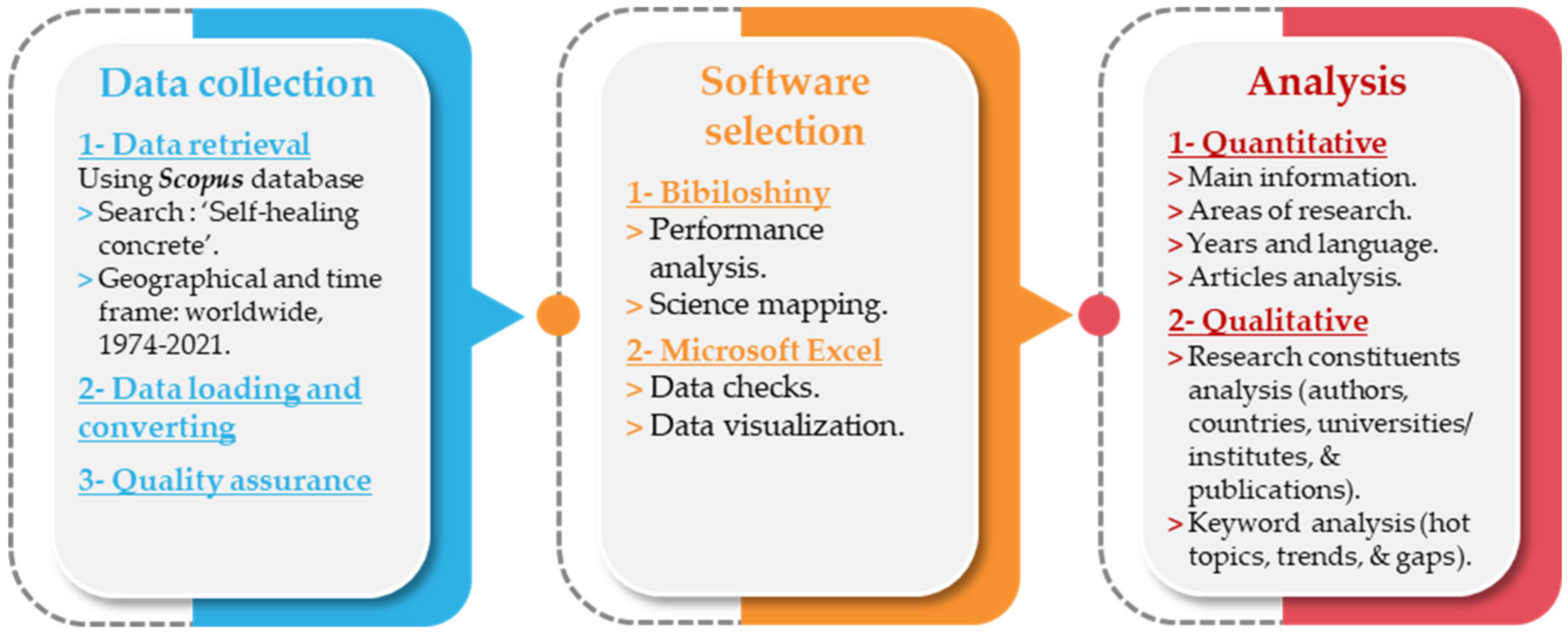

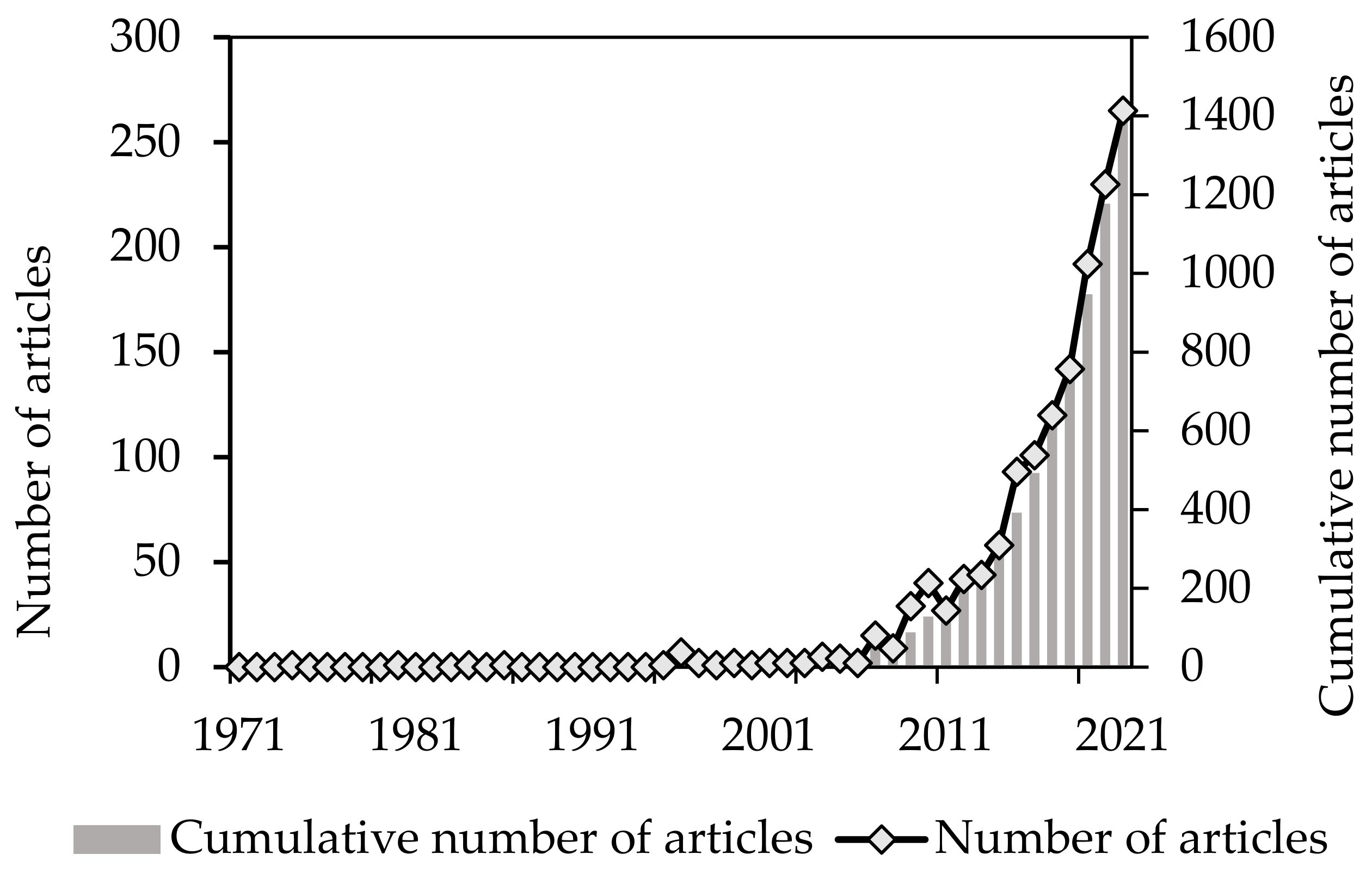
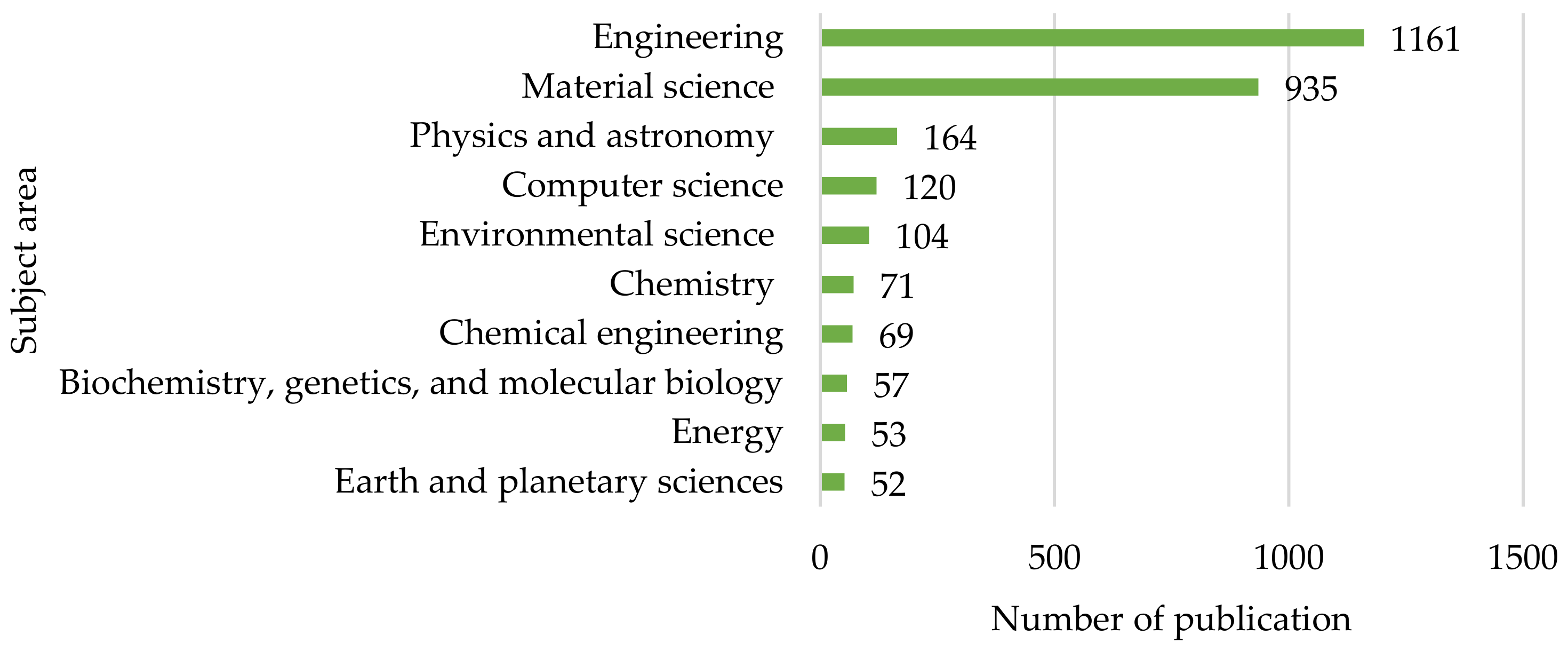


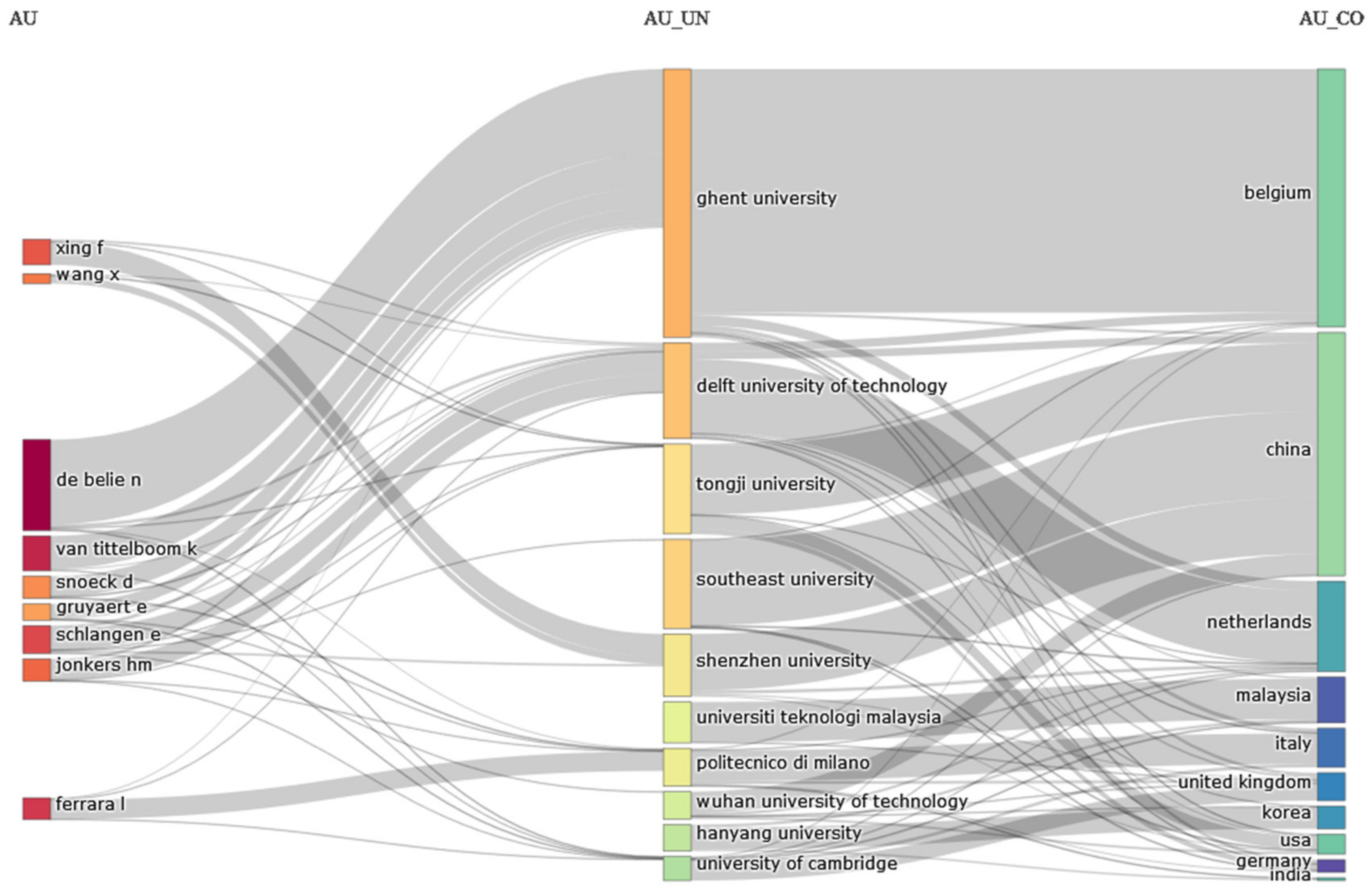

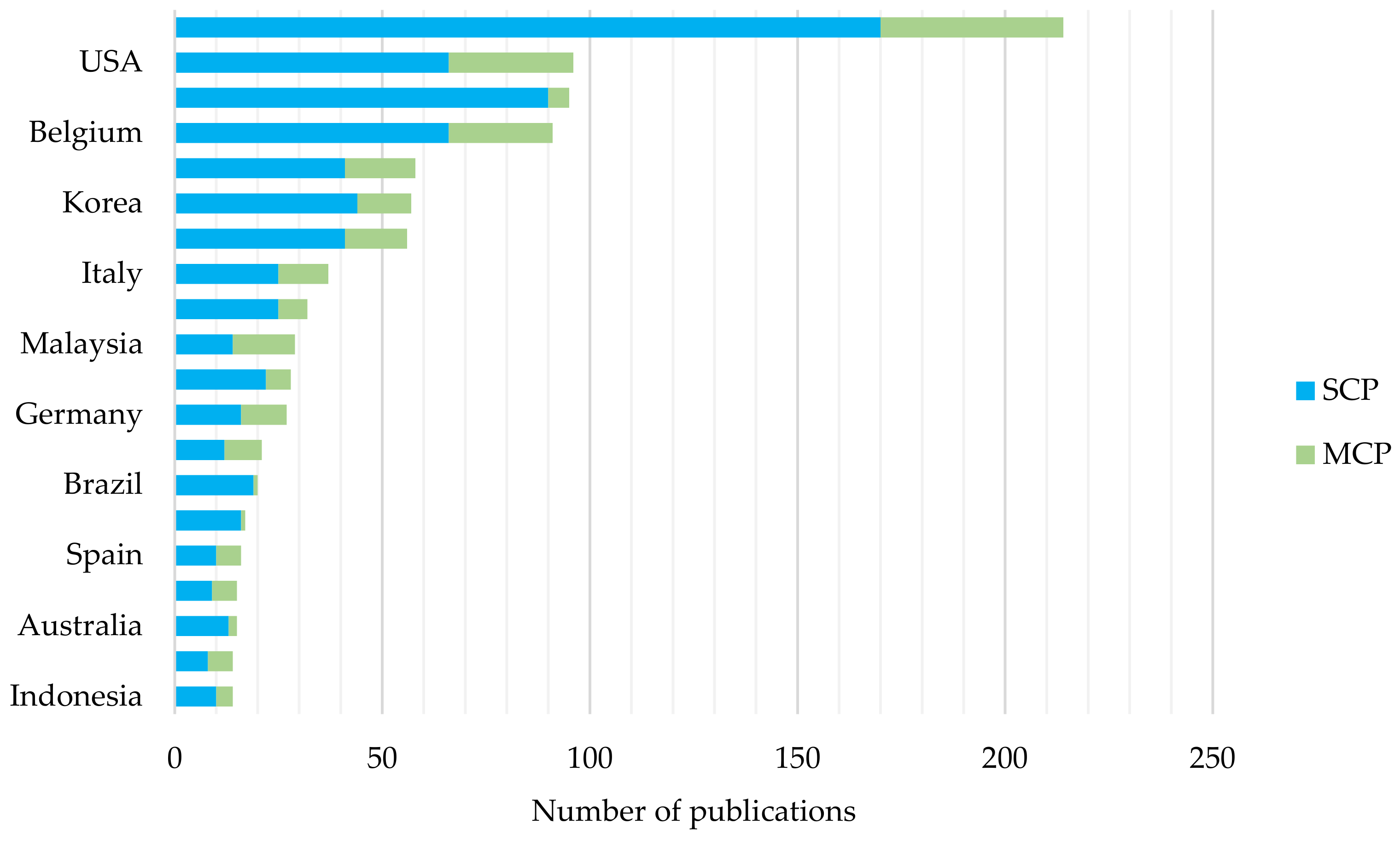
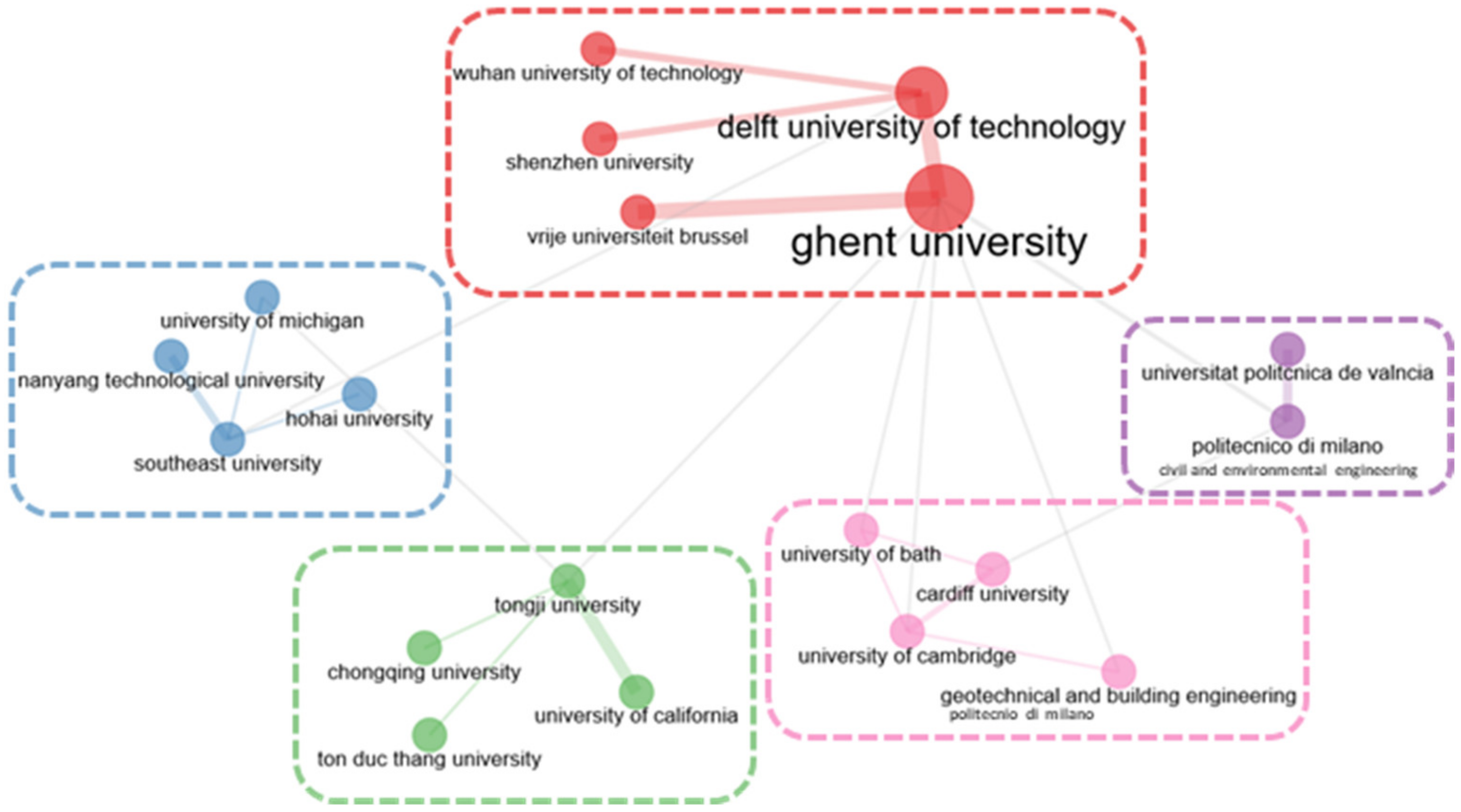
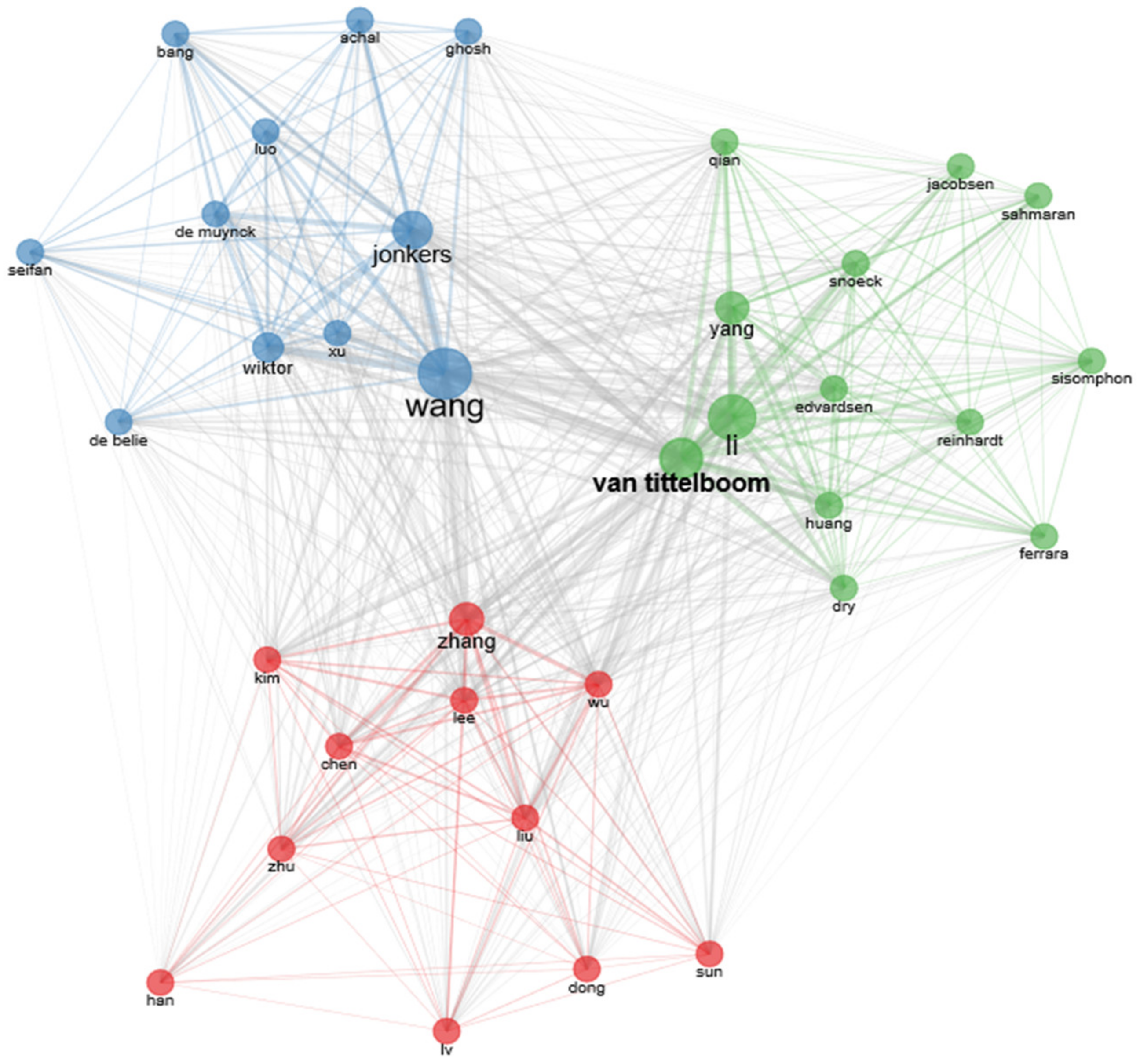


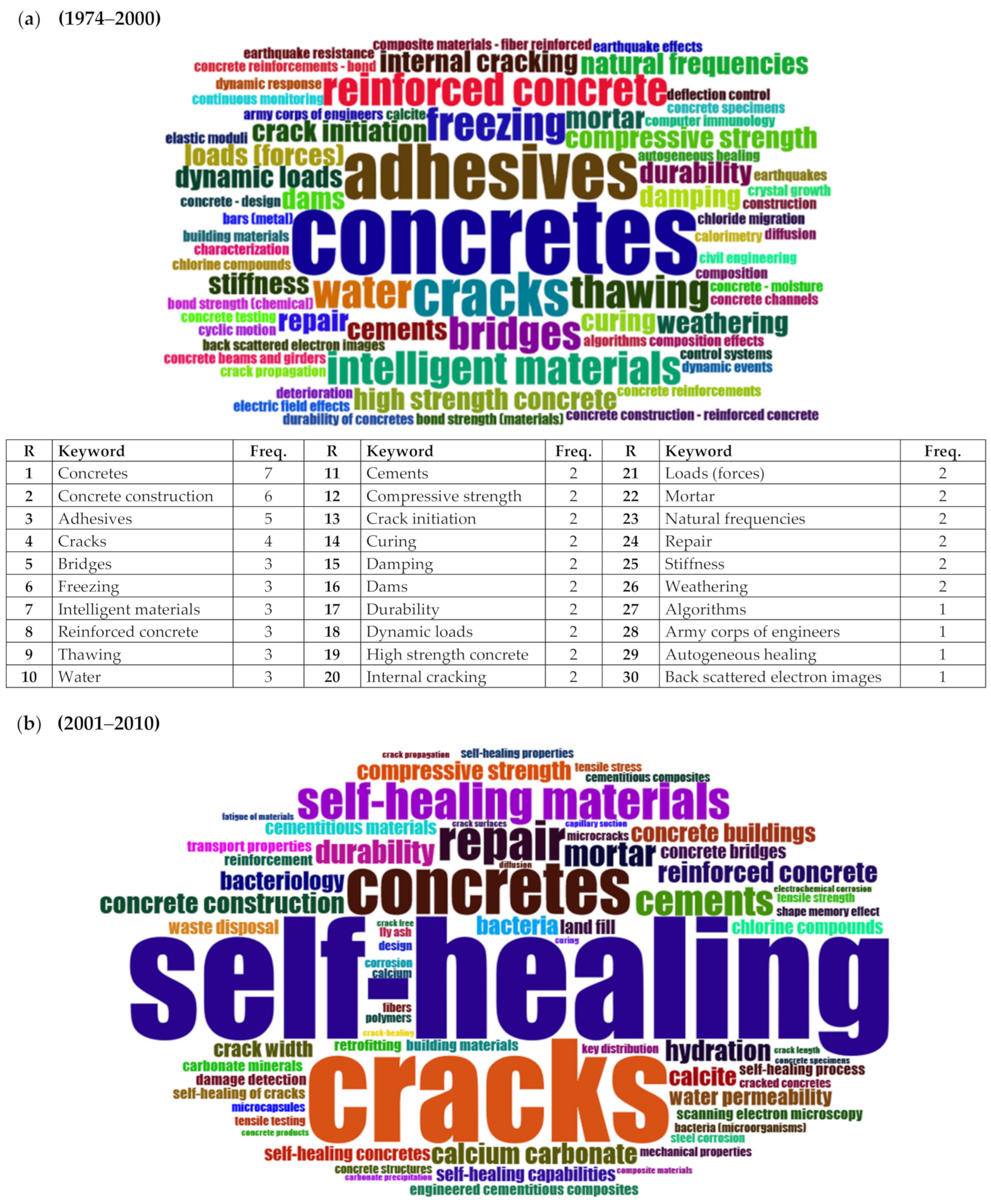
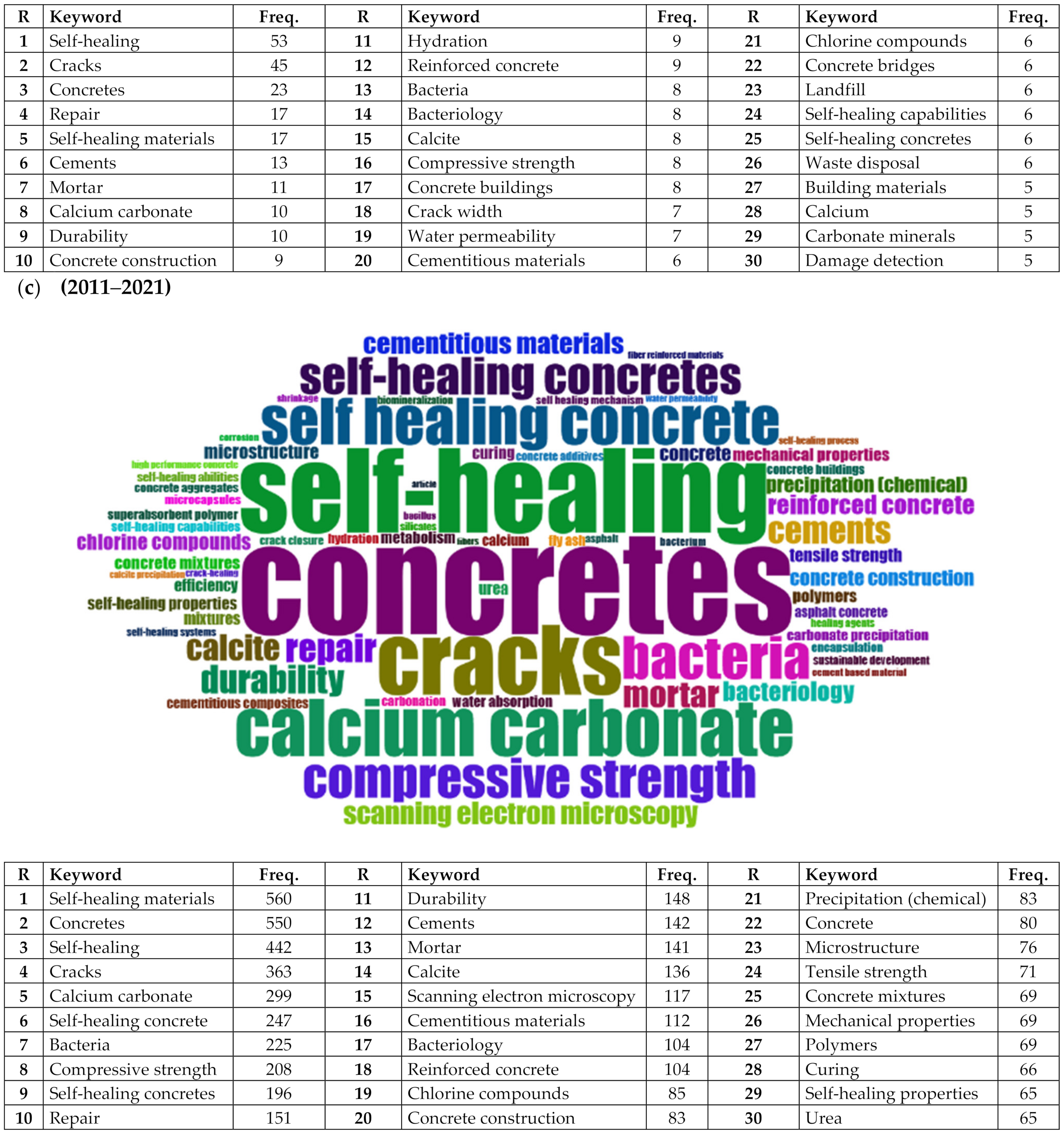
| Description | |
|---|---|
| Sources (Journals, Books, etc.) | 450 |
| Documents | 1433 |
| Average citations per document | 24.04 |
| Average citations per year per doc | 3.40 |
| References | 46,308 |
| Document contents | |
| Keywords plus | 6389 |
| Author’s keywords | 2584 |
| Authors | |
| Authors | 2961 |
| Author appearances | 5677 |
| Authors of single-authored documents | 57 |
| Authors of multi-authored documents | 2904 |
| Authors collaboration | |
| Single-authored documents | 106 |
| Documents per Author | 0.48 |
| Authors per Document | 2.07 |
| Co-Authors per Documents | 3.96 |
| Collaboration index * | 2.19 |
| R | Frequent Source | Publisher | P |
|---|---|---|---|
| 1 | Construction and Building Materials | Elsevier | 201 |
| 2 | Materials | Multidisciplinary Digital Publishing Institute | 73 |
| 3 | Cement and Concrete Composites | Elsevier | 55 |
| 4 | IOP Conference: Materials Science & Engineering | IOP Publishing | 33 |
| 5 | Journal of Materials in Civil Engineering | American Society of Civil Engineers | 31 |
| 6 | Materials Today: Proceedings | Elsevier | 28 |
| 7 | Lecture Notes in Civil Engineering | Springer | 25 |
| 8 | Cement and Concrete Research | Elsevier | 24 |
| 9 | Rilem Bookseries | Springer | 21 |
| 10 | Journal of Advanced Concrete Technology | Japan Concrete Institute | 18 |
| H-Index | G-Index | M-Index | ||||
|---|---|---|---|---|---|---|
| R | Source | Score | Source | Score | Source | Score |
| 1 | Construction and Building Materials | 49 | Construction and Building Materials | 85 | Construction and Building Materials | 3.3 |
| 2 | Cement and Concrete Composites | 32 | Cement and Concrete Composites | 53 | Cement and Concrete Composites | 2.1 |
| 3 | Cement and Concrete Research | 20 | Materials | 38 | Materials | |
| 4 | Materials | 20 | Journal of Materials in Civil Engineering | 25 | Applied Microbiology and Biotechnology | 1.7 |
| 5 | Journal of Materials in Civil Engineering | 15 | Cement and Concrete Research | 24 | Journal of Materials in Civil Engineering | 1.5 |
| 6 | Applied Microbiology and Biotechnology | 12 | Journal of Advanced Concrete Technology | 18 | Smart Materials and Structures | 1.3 |
| 7 | Journal of Advanced Concrete Technology | 12 | Smart Materials and Structures | 17 | Journal of Building Engineering | 1.3 |
| 8 | Smart Materials and Structures | 12 | Applied Microbiology and Biotechnology | 15 | Materials Today: Proceedings | 1.3 |
| 9 | ACI Materials Journal | 10 | ACI Materials Journal | 12 | Sustainability (MDPI) | 1 |
| 10 | Journal of Intelligent Material Systems and Structures | 8 | Transportation Research Record | 10 | Journal of Materials Research and Technology | 1 |
| Author * | Total Citations | Number of Publications | Publishing Start | Citations per Year ** | Citations per Publication *** |
|---|---|---|---|---|---|
| Nele De Belie | 6526 | 107 | 2010 | 593.3 | 61.0 |
| Henk M. Jonkers | 2838 | 34 | 2007 | 202.7 | 83.5 |
| Willy Verstraete | 2700 | 11 | 2010 | 245.5 | 245.5 |
| Kim Van Tittelboom | 2463 | 45 | 2010 | 223.9 | 54.7 |
| Erik Schlangen | 2433 | 41 | 2007 | 173.8 | 59.3 |
| Victor C. Li | 1635 | 15 | 2007 | 116.8 | 109.0 |
| Didier Snoeck | 1581 | 27 | 2012 | 175.7 | 58.6 |
| Jianyun Wang | 1303 | 21 | 2012 | 144.8 | 62.0 |
| Liberato Ferrara | 1235 | 41 | 2012 | 137.2 | 30.1 |
| Feng Xing | 1111 | 39 | 2011 | 111.1 | 28.5 |
| R | Country | P | Universities/Institutions | Freq. |
|---|---|---|---|---|
| 1 | China | 214 | Ghent University, Belgium | 203 |
| 2 | USA | 96 | Delft University of Technology, Netherlands | 103 |
| 3 | India | 95 | Southeast University, China | 71 |
| 4 | Belgium | 91 | Tongji University, China | 63 |
| 5 | Netherlands | 58 | Shenzhen University, China | 56 |
| 6 | Korea | 57 | Politecnico Di Milano, Italy | 44 |
| 7 | United Kingdom | 56 | Universiti Teknologi Malaysia, Malaysia | 28 |
| 8 | Italy | 37 | Wuhan University of Technology, China | 28 |
| 9 | Canada | 32 | Hanyang University, South Korea | 25 |
| 10 | Malaysia | 29 | University of Cambridge, UK | 23 |
| R | Paper Title | Citations | Year | C/Y | Country | Source-Publisher |
|---|---|---|---|---|---|---|
| 1 | Microbial carbonate precipitation in construction materials: A review [29] | 820 | 2010 | 74.5 | Belgium | Ecological Engineering—Elsevier |
| 2 | Application of bacteria as self-healing agent for the development of sustainable concrete [30] | 770 | 2010 | 70.0 | Belgium | Ecological Engineering—Elsevier |
| 3 | Self-Healing Materials [31] | 763 | 2010 | 69.4 | Germany | Advanced Materials—Wiley Online Library |
| 4 | Water Permeability and Autogenous Healing of Cracks in Concrete [32] | 628 | 1999 | 28.5 | Denmark | Materials Journal—American Concrete Institute |
| 5 | Quantification of crack-healing in novel bacteria-based self-healing concrete [33] | 582 | 2011 | 58.2 | Netherlands | Cement and Concrete Composites—Elsevier |
| 6 | Self-Healing in Cementitious Materials—A Review [34] | 486 | 2013 | 60.8 | Belgium | Materials—MDPI |
| 7 | Self-healing concrete by use of microencapsulated bacterial spores [14] | 471 | 2014 | 67.3 | Belgium | Cement and Concrete Research—Elsevier |
| 8 | Use of silica gel or polyurethane immobilized bacteria for self-healing concrete [35] | 415 | 2012 | 46.1 | Belgium | Construction & Building Materials—Elsevier |
| 9 | Permeability and self-healing of cracked concrete as a function of temperature and crack width [36] | 408 | 2003 | 22.7 | Germany | Cement and Concrete Research—Elsevier |
| 10 | Application of hydrogel encapsulated carbonate precipitating bacteria for approaching a realistic self-healing in concrete [37] | 281 | 2014 | 40.1 | Belgium | Construction & Building Materials—Elsevier |
| Country | Total Citations | Citations per Published Articles * |
|---|---|---|
| Belgium | 6288 | 69.10 |
| China | 4311 | 20.14 |
| USA | 3594 | 37.44 |
| Netherlands | 3407 | 58.74 |
| Germany | 1545 | 57.22 |
| India | 1479 | 15.57 |
| United Kingdom | 1178 | 21.04 |
| Japan | 956 | 34.14 |
| Italy | 881 | 23.81 |
| France | 825 | 55.00 |
Publisher’s Note: MDPI stays neutral with regard to jurisdictional claims in published maps and institutional affiliations. |
© 2022 by the authors. Licensee MDPI, Basel, Switzerland. This article is an open access article distributed under the terms and conditions of the Creative Commons Attribution (CC BY) license (https://creativecommons.org/licenses/by/4.0/).
Share and Cite
Alzard, M.H.; El-Hassan, H.; El-Maaddawy, T.; Alsalami, M.; Abdulrahman, F.; Hassan, A.A. A Bibliometric Analysis of the Studies on Self-Healing Concrete Published between 1974 and 2021. Sustainability 2022, 14, 11646. https://doi.org/10.3390/su141811646
Alzard MH, El-Hassan H, El-Maaddawy T, Alsalami M, Abdulrahman F, Hassan AA. A Bibliometric Analysis of the Studies on Self-Healing Concrete Published between 1974 and 2021. Sustainability. 2022; 14(18):11646. https://doi.org/10.3390/su141811646
Chicago/Turabian StyleAlzard, Mohammed H., Hilal El-Hassan, Tamer El-Maaddawy, Marwa Alsalami, Fatma Abdulrahman, and Ashraf Aly Hassan. 2022. "A Bibliometric Analysis of the Studies on Self-Healing Concrete Published between 1974 and 2021" Sustainability 14, no. 18: 11646. https://doi.org/10.3390/su141811646
APA StyleAlzard, M. H., El-Hassan, H., El-Maaddawy, T., Alsalami, M., Abdulrahman, F., & Hassan, A. A. (2022). A Bibliometric Analysis of the Studies on Self-Healing Concrete Published between 1974 and 2021. Sustainability, 14(18), 11646. https://doi.org/10.3390/su141811646









